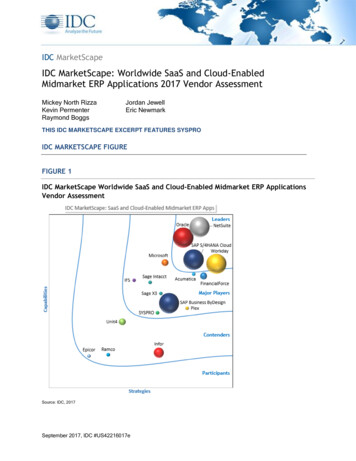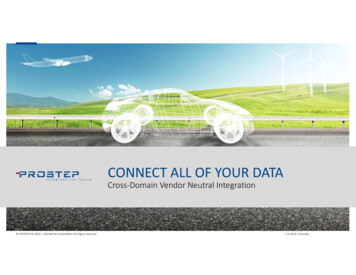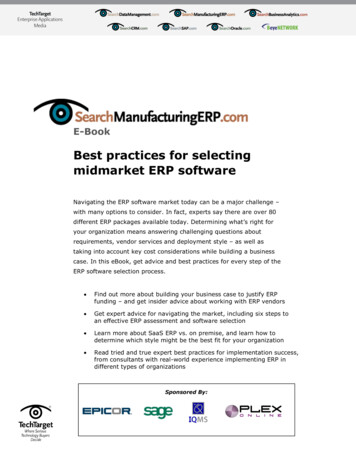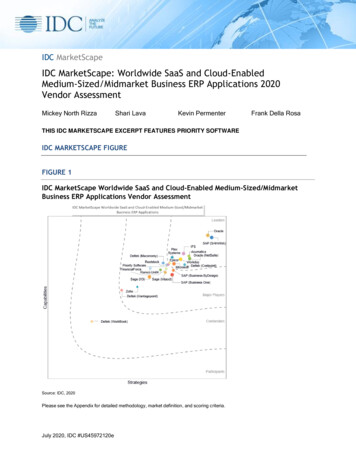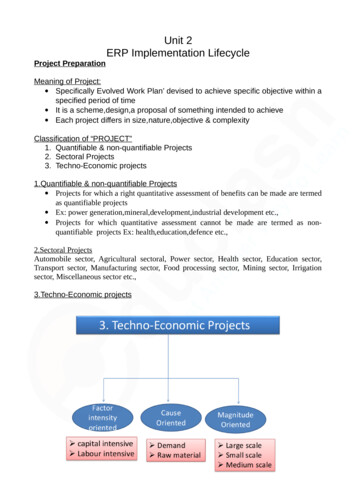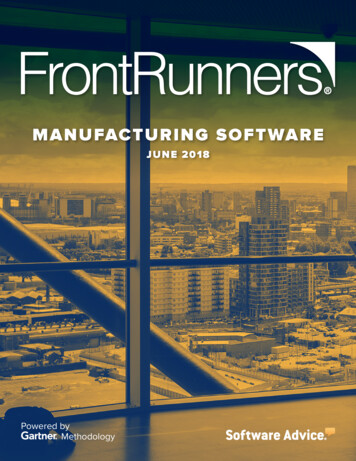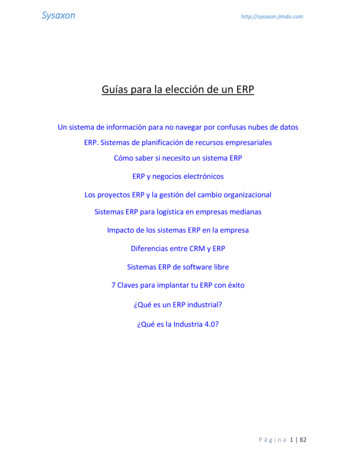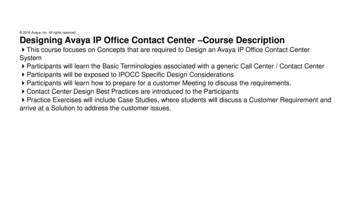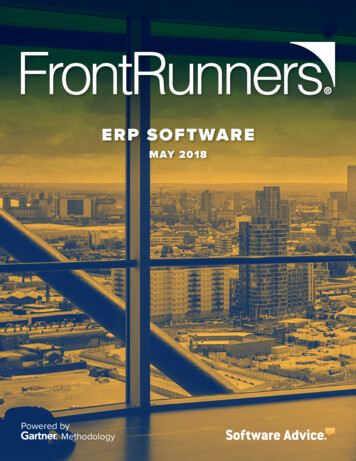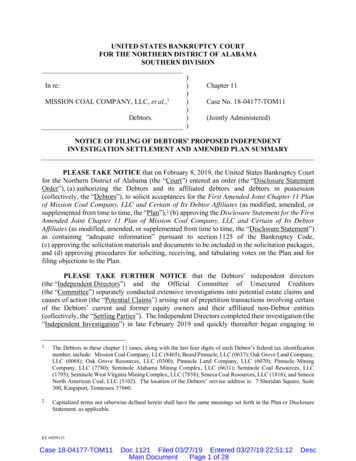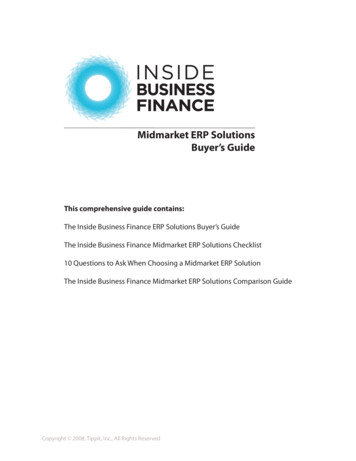
Transcription
Midmarket ERP SolutionsBuyer’s GuideThis comprehensive guide contains:The Inside Business Finance ERP Solutions Buyer’s GuideThe Inside Business Finance Midmarket ERP Solutions Checklist10 Questions to Ask When Choosing a Midmarket ERP SolutionThe Inside Business Finance Midmarket ERP Solutions Comparison GuideCopyright 2008, Tippit, Inc., All Rights Reserved
Learn what a midmarket ERP solution can do for you and understandwhat issues you should consider during your decision-making process.Midmarket ERP SolutionsBuyer’s GuideCopyright 2008, Tippit, Inc., All Rights Reserved2
The Definitive Guide to Midmarket ERP SolutionsContentsExecutive Summary3Midmarket ERP Solutions Overview6Market Overview8The Benefits of Midmarket ERP Solutions12Basic Features14Advanced usinessFinance.com3
The Definitive Guide to Midmarket ERP SolutionsExecutive SummaryFor all but the smallest organizations, an ERP (Enterprise ResourcePlanning) system promises big gains, helping to grow revenue, increaseproductivity companywide, improve efficiency throughout the enterpriseand manage costs. ERP integrates a variety of disparate systems, such asfinancials, SCM (Supply Chain Management) and CRM, automating timeconsuming processes and streamlining operations. With a unified viewof cross-company information, executives can ultimately make betterdecisions about corporate objectives and strategies.Right now, most of the ERP action is happening in the midmarket. Moreand more midsize companies — which are rather broadly defined asorganizations that earn more than 50 million annually in revenue but lessthan 1 billion — are looking to replace outdated ERP systems or jumpinto the technology for the first time.In fact, Boston-based AMR Research says in its “ERP Market Sizing Report,2006–2011,” “in the small and midsize business (SMB) segment, whichcontinues to outgrow the overall market, companies are buying new ERPsystems in response to new customer requirements and the desire toparticipate in the global market.”ERP solutions tailored to the midmarket abound, making it a buyer’smarket. In this age of mergers and acquisitions, many of theseorganizations were once small companies, and now, as midmarket3organizations, they need to consolidate various softwaresystems andstandardize business processes. Most companies in this space are copingwith increasingly complex operating environments, aging technology —including outmoded ERP systems — proliferating business-managementsoftware and, of course, the need to grow revenue.Midsize companies also face challenges specific to their industries.According to Aberdeen Group Inc., an IT research firm based in Boston,businesses that make consumer product goods are concerned aboutregulations and reporting requirements, while public-sector organizationsare worried about maintaining customer loyalty. Also, manufacturers areconcerned about the commoditization of their products. A robust ERPpackage can help address these issues, as well.Late last year, Aberdeen Group released its “2006 ERP in the Midmarket”study, which surveyed more than 500 organizations from a variety ofwww.InsideBusinessFinance.com4
The Definitive Guide to Midmarket ERP Solutionsindustries. It found that very few midsize companies — just 6 percent —don’t already have an ERP or MRP (Material Requirements Planning, theprecursor to ERP) implementation. For those businesses, the reasons totake a leap into ERP, which is largely considered necessary infrastructurefor midsize companies, are many and compelling. According to AberdeenGroup’s “2007 ERP in Manufacturing” report, 650 midsize companies citedthe availability of low-cost options; pressure from the parent company,suppliers or customers; “explosive” growth; compliance with regulatoryrequirements; and a “disastrous event” as factors convincing them of thevalue of ERP.At the same time, Aberdeen Group found that many ERP implementationsin the midmarket are quite mature and ripe for replacement. In the“2006 ERP in the Midmarket” report, 35 percent of respondents had ERPsystems older than 10 years, and 38 percent had ERP systems 5 to 10years old — and 22 percent of these were the organizations’ first ERPsystems that supplanted manual processes. ERP technology has evolvedsignificantly in the years since these systems were deployed, so many ofthese organizations have developed their own applications to make up forinadequacies.Many midmarket companies must now also choose an ERP system onwhich to standardize after multiple systems were installed, perhapsthrough mergers, across the enterprise. Aberdeen Group’s 2006 studyfound that 42 percent of midsize companies had two or more ERPpackages, and 16 percent had three or more ERP systems. Although it’s notnecessary, midsize companies seem to prefer consolidating their businessmanagement applications in one ERP package, at least in part to cut downon integration headaches.In its “2007 ERP in the Midmarket” survey, Aberdeen Group surveyedrespondents about their upgrade and replacement strategies, which is ingood part spurred by proliferating ERP systems. In one year, 9 percent planto replace their ERP package; in two years, 14 percent plan a replacement;and in three years, 25 percent plan a replacement. In addition toconsolidating multiple ERP systems, respondents want to replace theirERPs because 46 percent need more functionality than they currently have,39 percent are unhappy with outdated and clumsy user interfaces, and 37percent need a standardized solution with international capabilities.Vendors are aggressively vying for customers, launching new ERP solutionsdesigned to meet needs particular to the midmarket and pricing themto meet a midmarket company’s budget. To further entice midmarketcustomers, vendors are also developing vertical solutions that targetwww.InsideBusinessFinance.com5
The Definitive Guide to Midmarket ERP Solutionscertain industries, such as engineering, food and beverage, and fashion,with built-in functionality that cuts down on customization. In an effortto simplify the notoriously difficult implementation process, vendors arealso developing ERP systems that can be delivered in ways friendly toorganizations with limited IT resources; several now offer hosted solutions,and some are figuring out ways to offer this complex technology ondemand.Factored together, the decreasing costs of hardware, infrastructuretechnology and ERP software put a modern version of these once-epicbusiness-management packages within reach of any midsize company.In this Buyer’s Guide you will find details on what to look for in amidmarket ERP package, the benefits it should bring to your midsizecompany and what you need to know before you commit to a solution.www.InsideBusinessFinance.com6
The Definitive Guide to Midmarket ERP SolutionsMidmarket ERP Solutions OverviewAlthough vendors continually add new functionality to their ERP solutions,the technology itself is not new. In fact, some ERP fans date the technologyall the way back to 1960, when manufacturers began using the firstinventory-management and control systems, which evolved into MRPsystems in the 1970s. But ERP as we understand it today didn’t emergeuntil 1990, when vendors like SAP and BAAN Corp. expanded MRP fromcoordinating manufacturing processes to integrating a variety of back-endprocesses across the enterprise.Now, ERP systems are composed of several integrated modules thatreplace legacy systems, most of which are point solutions that operatedsolo in their respective departments. Modern ERP systems use a commoncorporate database to integrate not just multiple departments, but alsomultiple sites, for a truly companywide view. In this way, ERP gives greatervisibility into business processes across the company, including thefinance, human resources, manufacturing and marketing departments.Recently, the greatest change in the ERP market is scaling these complex,expensive systems to make them more accessible to midmarketcompanies. Vendors have also made ERP solutions easier to use andsimpler to implement, as well as reduced the amount of necessarycustomizations to fit the business, namely by adding features that supportcertain aspects of businesses that are common to midsize organizationsin a given industry. For instance, an ERP system tailored to the fashionindustry should use matrices specific to apparel, like sizes, colors andstyles. An ERP solution for government organizations should includeencumbrance accounting, while an ERP system for manufacturing shouldinclude support for environmental regulations.Vendors are also looking for ways to make the systems more agile sothat organizations can more quickly react to changes in the market. Atthe same time, the many midsize companies that do use ERP need to“derive more and better business value from their ERP implementations,”according to Aberdeen Group, which means that they should utilize morethan the 45 percent of functionality they current use in their ERP systems.Even if your organization chooses a vertical solution with out-of-the-boxfeatures that support your industry-specific needs, you will face choicesabout functionality and customization. The time is right during an ERPimplementation to standardize business processes across the network —which should make it easier to carefully align your organization’s businesswww.InsideBusinessFinance.com7
The Definitive Guide to Midmarket ERP Solutionsprocesses with the ERP software’s functionality. Midsize companiesin particular should be wary of customizing the software to matchbusiness processes. In fact, if you’ve chosen the right solution, very fewmodifications should be necessary.And for most midmarket companies, the features offered by an ERPsolution are the key deciding factors in selecting software. In fact, inAberdeen Group’s “2006 ERP in the Midmarket” survey, about 70 percent ofrespondents cited functionality as the top criteria, followed by total cost ofownership and ease of use.Almost every midmarket ERP solution includes the same modules, butthe features within those modules can vary greatly depending on thevendor’s history and core competencies. For instance, a vendor that rosefrom the manufacturing-operations software is likely to specialize in themanufacturing and perhaps supply-chain aspects of ERP. In general, anERP system’s core modules are: BI (Business Intelligence) CRM Financial management HCM (Human Capital Management) Manufacturing operations SCMAs vendors expand their offerings, they may also include modules tosupport lean manufacturing, BPM (Business Process Management),EAM (Enterprise Asset Management), and SRM (Supplier RelationshipManagement).The modules that compose an ERP package are barely a drop in the bucketwhen it comes to understanding what features it offers your organization.Choosing the right solution requires digging deep into its functionalityand matching it to your organization’s business processes, and ultimately,its corporate strategies and business goals.www.InsideBusinessFinance.com8
The Definitive Guide to Midmarket ERP SolutionsMarket OverviewConsolidation among vendors has been the hallmark of the ERP marketin recent years, starting among the industry leaders for enterprise-scaleERP — most notable was the hotly-contested acquisition of PeopleSoftInc. by Oracle, Corp., which also purchased JD Edwards. Taking the giants’lead, midmarket companies are also consolidating. Alpharetta, Ga.-basedInfor acquired MAPICS Inc., Geac, SSA Global Technologies Inc. and HansenInformation Technologies. Intentia merged with Lawson Software, whichhas headquarters in St. Paul, Minn. And Sage Software Inc., which has itsdivision offices scattered across the Unites States, bought Adonix NorthAmerica and Best Software.Vendors in this space are also adding functionality to their ERP offeringsthrough acquisitions, rather than developing it internally. Infor again hasbeen particularly busy — the vendor made several supply-chain-focusedacquisitions, then bought Datastream for EAM, Formation Systems LLCfor product-specifications management, Extensity for performancemanagement and Workbrain for HCM. Irvine, Calif.-based Epicor SoftwareCorp. bought CRS Retail systems to add retail operations to its portfolio ofvertical offerings. Santa Barbara, Calif.-based QAD Inc. acquired PrecisionSoftware for GTM (Global Trade Management) and Bisgen for SFA (SalesForce Automation) capabilities. Oracle continued its buying spree bypurchasing Retek for retail operations and Siebel for CRM. And Microsoftacquired eBECS Ltd. for its lean manufacturing capabilities.According to AMR Research’s “2007 ERP Providers Serving the Midmarket,”the ERP market will continue to grow at 18 percent, largely through addon functionality. Vendors will continue their acquisitions, with the “goal tocreate product portfolios and be a single source of business applicationsfor their customers and prospects.”Like their customers, most midmarket ERP vendors are global companieswith offices around the world. Sage Software’s parent company isin Newcastle upon Tyne, England; Lawson has headquarters also inStockholm, Sweden; and SAP is headquartered in Walldorf, Germany, withoffices around the world. Exact Software has headquarters in Delft, theNetherlands, as well as offices in Europe; the Middle East; Asia; Australia;Africa; and North, Central and South Americas. From California, Oracle,NetSuite Inc., QAD and Epicor Software operate across Europe, the MiddleEast, Africa and Asia.www.InsideBusinessFinance.com9
The Definitive Guide to Midmarket ERP SolutionsThe space for midmarket ERP offerings is crowded and is getting evenmore competitive as Oracle and SAP, already dominating the marketamong large global companies, aim for the midmarket. But it’s not aneasy fight — several vendors that cater to the midmarket are entrenched,including Infor, Lawson Software, Epicor Software, QAD, Sage Softwareand Microsoft. According to AMR Research, many midmarket vendors,including Epicor Software, Sage Software and QAD, are cross-selling“back to their installed bases to defend their turfs in specific geographiesand sub-industry segments against the downmarket advances of largervendors.”When it comes to specific offerings for midsize companies, many of thesevendors don’t stick to just one. Some vendors, such as Epicor Software,work with the customer to determine which vertical solution is the best fit.Others give midsize companies a few different options to start with.Epicor SoftwareSince its founding in 1984, Epicor has focused on providing businessmanagement software to midsize and small companies. It has morethan 20,000 customers around the world and provides solutions in 33languages. Midmarket customers choose between Epicor Enterprise, anend-to-end CRM suite with industry-specific solutions, and iScala, whichtargets the divisions and subsidiaries of large local and regional companieswith an end-to-end ERP solution.Exact SoftwareExact Software, also founded in 1984, targets the midmarket with MacolaES, which includes native BPM capabilities; e-Synergy, a Web-basedcollaboration platform that integrates with the ERP solution; and MAX,which is ERP for small to midsize manufacturers with SQL environments.Exact has 180,000 customers using solutions in 40 languages.InforInfor offers the broadest range of ERP products, some of which areappropriate to the midmarket and tailored to industry subsectors. Forinstance, Infor ERP TRANS4M is for the automotive industry, and InforERP Adage is for the process industries. In addition, this vendor providesindustry-specific feature packs for its mass-market products, such as InforERP LN. Infor ERP is built on an SOA (service-oriented architecture), so thesolutions are flexible and scalable. Infor has 70,000 customers around theworld, and its solutions support multiple languages.www.InsideBusinessFinance.com10
The Definitive Guide to Midmarket ERP SolutionsLawson SoftwareFounded in 1975, Lawson Software has 4,000 customers using its M3and S3 ERP offerings. M3 is tailored to customers who make, move andmaintain products, and S3 targets customers in service industries that staff,source and serve. Cross-industry applications include financials, HCM, BIand asset management. AMR Research said, “Key differentiators of the M3product are its ability to support mixed-mode manufacturing and supplychain planning, including the integration of production planning withplant asset maintenance requirements, aftermarket service capabilities,and attribute management.”MicrosoftMicrosoft’s Dynamics (previously called Business Solutions) division offersfour different midmarket ERP packages: Dynamics GP, which is a scalablebusiness management solution for growing and midsize companies;Dynamics AX, which provides industry-specific functionality to midsizeand larger companies; Dynamics SL, which targets project-driven midsizeorganizations; and Dynamics NAV, which is suitable for small and midsizeorganizations. According to AMR Research, Microsoft Dynamics has105,000 midmarket customers using Dynamics AX, NAV and GP.NetSuiteFounded in 1998 and headquartered in San Mateo Calif., NetSuite targetsgrowing midmarket business with its Web-based business-managementsystem. The company’s NetSuite application includes modules for ERP,CRM, e-commerce, marketing automation and more. NetSuite servescustomers across a variety of industries, such as software, finance,education, manufacturing and retail.OracleOracle continues to offer the PeopleSoft Enterprise and JD EdwardsEnterpriseOne suites, as well as Oracle E-Business as its midmarket ERPofferings. PeopleSoft Enterprise is an industry-focused suite of businessapplications that is suitable for growing companies and governmententities. PeopleSoft Enterprise has easy-to-implement modularly, andit offers an unusual breadth of features for the midmarket. JD EdwardsEnterpriseOne, an integrated applications suite of ERP software, is alsogood for growing companies and government entities. JD Edwards wasfounded in 1977 as an ERP software company, and Oracle continues tooffer it in 23 languages and localized versions around the world. All told,AMR Research reports that the vendor has more than 19,000 midmarketERP customers.www.InsideBusinessFinance.com11
The Definitive Guide to Midmarket ERP SolutionsQADQAD was founded in 1979 with a focus on providing systems to globalmanufacturers. The vendor now has 5,500 customers using its EnterpriseApplications around the world; the ERP applications are also available inlocalized versions and support 27 languages.Sage SoftwareSage Software’s midmarket offerings are Sage MAS 90 and 200, as well asMAS 500, which are used by 55,000 customers worldwide. MAS 90 and200 are both modular solutions with a range of accounting and businessmanagement features. MAS 200 simply adds a thin client/server platformto the mix. MAS 500 adds to the financial accounting software BI, orderprocessing, distribution and manufacturing capabilities.SAPLike Oracle, SAP is breaking into the lucrative midmarket with more thanone midsize-appropriate offering. SAP currently has more than 24,000midmarket customers. Its current midmarket offering is Business Allin-One, which includes micro-vertical and industry-specific businessprocesses. All-in-One is based on SAP ERP, one of the enterprise-scaleproducts that plays in the global market. It includes SAP Best Practices,which are preconfigured business scenarios that can guide customersthrough configuring their business processes for SAP applications.www.InsideBusinessFinance.com12
The Definitive Guide to Midmarket ERP SolutionsThe Benefits of Midmarket ERP SolutionsAn ERP package should provide an organization with a solid foundation,incorporating all of the fundamental aspects of running a business.Expectations run high when an organization deploys an ERP package— if the solution is a good fit for the company, the company stands togain tremendous cost savings and service improvements across theenterprise. Manual processes are automated, production scheduling ismore efficiently managed and inventory is more accurately assessed. Also,business performance can be measured in a much more holistic fashionthan ever before. This gives executives real-time visibility into all businessprocesses, enabling them to make better strategic decisions. In short,with the right ERP package, a midmarket company can compete moreaggressively in global markets.An ERP implementation can reduce costs in three primary categories,according to Aberdeen Group’s “2007 ERP in the Midmarket” report:inventory costs, manufacturing operating costs and administrative costs.The survey’s best-in-class respondents reported a 21 percent decreasein inventory costs, a 17 percent decrease in manufacturing operatingcosts and a 16 percent decrease in administrative costs. The averagerespondents’ reductions were 11 percent, 8 percent and 9 percent,respectively.Because an ERP solution has its fingers in all aspects of running a business,its benefits are myriad and go beyond tangible cost reductions. It canimprove an organization’s customer service and response time whensolving issues. It can solve issues of interoperability among multiplemanufacturing locations. It can standardize and accelerate manufacturingprocesses in all of a company’s manufacturing sites. It can streamline amanufacturer’s order-fulfillment processes. It can facilitate connectingwith partners’ and suppliers’ enterprise systems. ERP can even help anorganization maintain compliance with government regulations, fromhiring practices to environmental laws.Case studies done on specific ERP implementations reveal a varietyof different business-specific benefits. For instance, Tumi revealed toAberdeen that by replacing legacy systems with an integrated ERPpackage, the travel-accessories manufacturer reduced its inventory levelsby 30 percent, reduced its warehouse space requirements by 38 percent,improved its month-end close process by five days, reduced its DSO (DaysSales Outstanding) by 44 percent and increased sales by 100 percentwithout hiring new employees.www.InsideBusinessFinance.com13
The Definitive Guide to Midmarket ERP SolutionsVarious ERP vendors list on their Web sites several gains made by theircustomers, including: TUFF SHED Inc. increased processing from 60,000 transactionsper day to 60,000 transactions per minute and shrank its monthlyfinancial review cycle to 5 days from 15 days with Oracle JD EdwardsEnterpriseOne TRW Automotive reduced its scheduling time by as much as 75percent with QAD With Microsoft Dynamics GP, the City of Waconia, Minn. can completeits utility-billing process 47 percent faster Zurn Plumbing Products estimates that it will save 250,000 to 300,000 per year in ongoing IT expenses with Microsoft Dynamics AXwww.InsideBusinessFinance.com14
The Definitive Guide to Midmarket ERP SolutionsBasic FeaturesComparing midmarket ERP packages is not exactly an apples-to-applestype of exercise. Each vendor wraps its midmarket offering with differentfunctionality, tailored to the needs of the kinds of companies the solutionis intended for and based on the vendor’s particular areas of expertise.For instance, Epicor Software’s Enterprise offering targets the businessservices sector, while Infor’s various industry-specific solutions are wellsuited to discrete and project-based manufacturers. Lawson Software’sERP offering supports asset-intensive industries, such as fashion, andOracle PeopleSoft Enterprise is good for companies that have complexsourcing needs.Nevertheless, almost every midmarket ERP suite shares several commonmodules: BI, CRM, financial management, HCM, manufacturing operationsand SCM.The differences among solutions tend to be quite granular within thesemodules. Also, even if different packages offer the same feature — say,sales-order management — it might not be bundled in the same module;some vendors include sales-order management in their CRM suites whileothers package it in their SCM suites.Key to an ERP package is tight integration between modules, so that allof the core business modules are related. For instance, manufacturingoperations are integrated with customer service, logistics and delivery.SAP describes a string of events in its ERP product: “ a new customerorder automatically initiates an appropriate warehouse action and productshipments trigger billing processes. Sales, production and purchasinggroups work seamlessly together to fulfill critical customer orders andadapt production levels to changes in market demand.”Business IntelligenceOne of the newer components of most modern midmarket ERP packages,BI shines a bright light into the heart of a company’s performance. Ingeneral, an ERP suite’s analytics or BI tools allow users to share and analyzethe data that the ERP applications collect from across the enterprise froma unified repository. The end result is more informed decision makingby everyone from executives to line managers to human-resourcesprofessionals to accountants. A variety of automated reporting andanalysis tools can help streamline operations, as well as improve anorganization’s business performance. With greater control and visibility ofdata across the enterprise, business leaders can better align the company’soperations with its overarching strategic goals.www.InsideBusinessFinance.com15
The Definitive Guide to Midmarket ERP SolutionsFor instance, Epicor’s BI suite includes data warehouse, budgeting, andfinancial- and management-reporting tools, as well as performancedashboards, which present critical metrics in subject-specific, single-pagedigests. Oracle’s analytics tools for the JD Edwards EnterpriseOne ERPapplications include customizable data marts, dashboards and differentdata models to help consolidate business information. The PeopleSoft BIapplications give each user relevant information specific to his or her job,including built-in best practices sorted by role, function and industry. Also,QAD’s BI tools include data warehousing, templates for predefined reportsand KPIs (Key Performance Indicators), and dashboards.CRMCRM has long been a core component of any ERP offering, givingmanufacturers a way to improve customer service by pulling togethertools to fulfill customers’ orders, respond to customers’ service needs, andoften, create marketing campaigns to reach customers.Most vendors include sales tools to provide customers with sales quotes,process their orders and offer flexible pricing on their products. Anotherimportant CRM component is service management, which may armcustomer-service agents with scripts for talking to customers, as well asallow them to authorize product returns and search a knowledge baseof support information. The third main component is usually marketing,which may include tools to manage campaigns, create sales literature anddevelop a library of marketing collateral.Additionally, CRM often has tools for account management, SFA, andopportunity or lead management, as well as self-service tools forcustomers and an e-commerce storefront builder.Financial ManagementOf all the ERP modules, the financials applications tend to be the mostfrequently utilized. Across the board, these include general ledger,accounts receivable and accounts payable, billing, and fixed assetmanagement. Because many midmarket companies deploy ERP to supportefforts at breaking into global markets, it is imperative that their ERPpackages support multiple currencies and languages. as well as regulatorycompliance in the U.S. and in foreign countries.The financial-management applications may also include tools for creatingand adhering to budgets, cash-flow management, expense management,risk management and tax management.www.InsideBusinessFinance.com16
The Definitive Guide to Midmarket ERP SolutionsHCMHCM and PeopleSoft provide an excellent example of the modularityof ERP, as well as insight into an offering’s technical strengths based onthe vendor’s history. PeopleSoft was founded as a human-resourcesmanagement company, and the PeopleSoft Enterprise HCM modulecontinues to be a key asset of this ERP package, offering the broadest setof features found in products in this Buyer’s Guide.For the most part, the HCM module includes tools for human-resourcesmanagement, performance management, payroll, and time and labortracking. Some vendors also provide functionality for administeringbenefits, managing compensation, dealing with salary taxes, recruitingnew employees and planning workforce needs. Some also include selfservice tools for managers and employees.Even though HCM is generally considered core ERP functionality, manyvendors — including Infor, Lawson Software and Microsoft — offer it as anadd-on module. QAD is the one midmarket vendor that doesn’t offer anHCM solution.Manufacturing OperationsThe manufacturing module is where much product differentiationhappens, including industry-specific functionality. In general, theseapplications are intended to make manufacturing operations moreefficient and simple. Most vendors support different modes ofmanufacturing, include configurable product capabilities, performdifferent types of job costing and offer a BOM (bill of materials) tool.Applications often include PDM (Product Data Management), CRP(Capacity Requirements Planning), MRP (Materials RequirementsPlanning), forecasting, MPS (Master Production Scheduling), work-ordermanagement and shop-floor control.SCMOf all the ERP modules, SCM has the greatest variability between vendors:It is vast and varied, yet often adapted to the needs of specific industries.In general, SCM improves the flow of materials through an organization’ssupply chain by “managing planning, scheduling, procurement, andfulfillment for optimum service levels and maximum profitabilit
management and Workbrain for HCM. Irvine, Calif.-based Epicor Software Corp. bought CRS Retail systems to add retail operations to its portfolio of vertical o# erings. Santa Barbara, Calif.-based QAD Inc. acquired Precision Software for GTM (Global Trade Management) and Bisgen for SFA (Sales Force Automation) capabilities.
